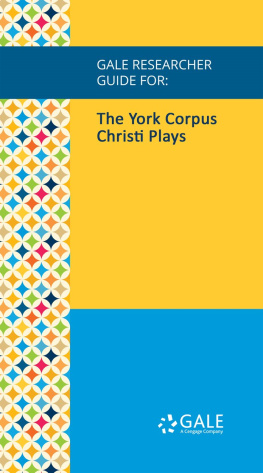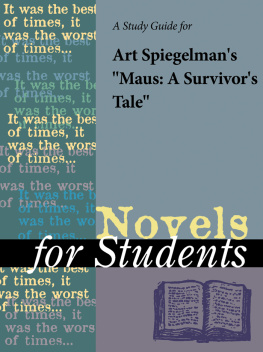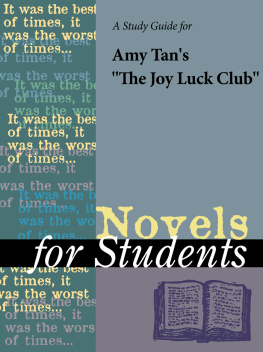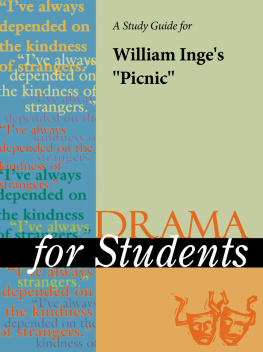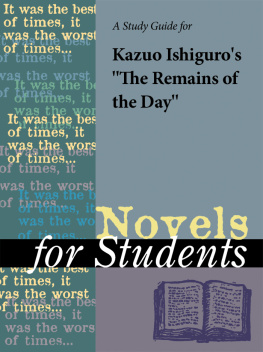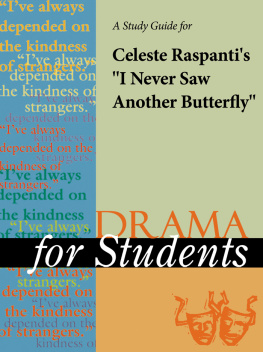TABLE OF CONTENTS
Guide
Gale Researcher Guide for: The York Corpus Christi Plays
Content Strategist: Julie Carnagie Pitlock
Graphic Design Specialist: Kristine Julien
2018 Gale, a Cengage Company
ALL RIGHTS RESERVED. No part of this work covered by the copyright herein may be reproduced or distributed in any form or by any means, except as permitted by U.S. copyright law, without the prior written permission of the copyright owner.
For product information and technology assistance, contact us at Gale Customer Support, 1-800-877-4253.
For permission to use material from this text or product, submit all requests online at www.cengage.com/permissions.
Further permissions questions can be emailed to permissionrequest@cengage.com.
While every effort has been made to ensure the reliability of the information presented in this publication, Gale, a part of Cengage Learning, does not guarantee the accuracy of the data contained herein. Gale accepts no payment for listing; and inclusion in the publication of any organization, agency, institution, publication, service, or individual does not imply endorsement of the editors or publisher. Errors brought to the attention of the publisher and verified to the satisfaction of the publisher will be corrected in future editions.
Gale
27500 Drake Rd.
Farmington Hills, MI, 48331-3535
97-815-358-526-78 (Consumer)
97-815-358-526-61 (Library)
The York Corpus Christi Plays
Margaret Rogerson
University of Sydney
Department of English
Associate professor Margaret Rogerson received her doctorate from the University of Leeds. Her publications include a coedited collection of medieval dramatic records from York (1979), a monograph on modern productions of the York Plays (2009), and an edited collection of essays spanning their medieval and modern performance (2011).
The York Corpus Christi Plays were community events sponsored by local trading and craft guilds that were presented outdoors on Corpus Christi Day, a religious festival celebrating the transubstantiation of bread and wine into the body and blood of Christ during the Eucharist. From the late fourteenth century up until 1569, the plays followed a set route through the streets of York, England, on pageant wagons, stopping at various stations to perform. Their narrative was based on the Bible, opening with the story of Creation, moving through Old Testament events foreshadowing the Life and Passion of Christ (the plays major focus), and concluding with the Last Judgment. The city council exercised control over the plays and promoted them to reinforce piety, reform morals, and suppress vice in honor of God and the city. In the twenty-first century, scholars recognize the cultural importance of the York Corpus Christi Plays alongside the works of William Shakespeare and other dramatists of the era. The plays continue to be a part of Yorks modern history after having been revived during the Festival of Britain in 1951, a secular celebration of the United Kingdom and its people.
The York Corpus Christi Plays are a cycle of religious dramas that depict scenes from the Bible. The plays took place outdoors in the northern English town of York in the late medieval era on the occasion of Corpus Christi Day. Written in powerful alliterative verse, they were performed on traveling wagons that rolled through the town. Sponsored by guilds, the plays likely involved hundreds of townspeople and were a festive highlight of the year, taking place during the early days of summer. Contemporary documents reveal the logistics of staging the event, and iconography in local churches sheds light on the plays visual and spiritual aspects. Stage directions and notes in the text reveal that sacred music embellished some of the plays, and the original route is still accessible in the twenty-first-century city. Significantly, the local community in York is committed to continuing the tradition as a celebration of its rich history.
Origins
The earliest surviving medieval document related to the York plays is dated 1377 and refers to the storage of wagons on which the plays were performed. Undoubtedly, the plays already existed in some form before this date, but how and why they originated remains a matter of debate. Richard Beadle and Pamela M. King suggest in York Mystery Plays: A Selection in Modern Spelling that the plays emerged at a time of prosperity after the Black Death of 1349 (1995, ix). R. B. Dobson argues in Craft Guilds and City (1997) that the establishment of the guild system in the late fourteenth century gave rise to the plays, while P. J. P. Goldberg claims in the 1997 essay Craft Guilds, the Corpus Christi Play and Civic Government that it could be the other way around.
The impetus for the plays may also have been a liturgical procession on Corpus Christi Day involving guilds and civic leaders. It followed the same route as the plays, deviating only after reaching the gates of the Minster, the cathedral church of York. First, Mass was celebrated at the church of Holy Trinity Priory in Micklegate, and the consecrated Host was paraded to the Minster Gates, where the procession turned left to St. Leonards Hospital, a charitable establishment within the Minster grounds that cared for the poor, sick, elderly, and disabled. At the Minster Gates, the plays turned right toward the Pavement, the commercial heart of the city. On Corpus Christi Day, the procession originally set off before the plays, but in 1476 it was transferred to the following day, thus leaving the plays to proceed alone.
Meg Twycross suggests in The Ordo paginarum Revisited with a Digital Camera that in 1415 there may not have been fully fledged plays but groups of costumed characters posed on a pageant wagon, or marching along the route (2007, 111). The implication is that there could have been a gradual development from a processional display to scripted drama.
Corpus Christi
Corpus Christi Day varies with the date of Easter, falling on a Thursday between May 21 and June 24, a time potentially conducive to outdoor events. Yorks civic rulers considered that the plays fulfilled the spiritual obligation of honoring Christ on the festival day, a fact that the first plays opening words, delivered by the actor playing God the Father, confirm: Ego sum Alpha et O (Omega): vita, via, veritas, primus et novissimus [I am alpha and omega: the life, the way, the truth, the first and the last] (Beadle 2009, 3).
Beadle points out in The York Plays that the Latin conflates Revelation 22:13, Christs promise of his Second Coming for the Last Judgment, and John 14:6, Christs words at the Last Supper, and thus represents an epigraph to the plays, evoking the beginning and end of time and the occasion of the institution of the Eucharist, Corpus Christi (2013, 4).
Terminology
Originally the event was called Corpus Christi Play, or the pageants, which also referred to the wagon stages. Scholars have called the plays a cycle, in that they portray the life cycle of humanity, from the beginning to the end of time. The plays can also be termed scriptural or biblical with reference to their content, although they also include legendary material, or craft cycles, referring to their guild sponsorship. Another designation is mystery plays, referring to the mysteries of religious faith or their guild sponsors, which were also called

